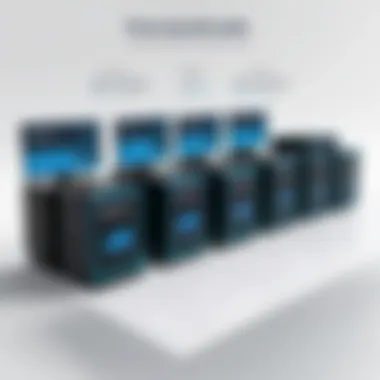SentryOne Task Factory: A Comprehensive Overview


Intro
In today's data-driven landscape, organizations are inundated with vast amounts of information. Tools that streamline the processes of data integration and transformation have become essential. SentryOne Task Factory emerges as a pivotal solution in this context, offering users a comprehensive suite of features designed to enhance Extract, Transform, Load (ETL) operations. For IT professionals and business decision-makers, understanding Task Factory’s capabilities can lead to effective data management strategies that influence overall business performance.
This article delves into the core attributes of SentryOne Task Factory. Here, we will explore its key features, analyze different pricing models, and assess its position within the competitive landscape. By the end, readers will have a thorough grasp of how this tool contributes to modern data management and analytics, tailored to accommodate the varying needs of organizations, irrespective of their size.
Preamble to SentryOne Task Factory
SentryOne Task Factory represents an essential tool in the repertoire of data integration and ETL (Extract, Transform, Load) processes. In today’s data-driven world, organizations need effective solutions that can streamline data workflows, ensure data accuracy, and enhance operational efficiency. Understanding the significance of SentryOne Task Factory is crucial for professionals looking to optimize data management strategies.
Overview of Task Factory
SentryOne Task Factory is designed to enhance SQL Server Integration Services (SSIS) by providing a comprehensive collection of tasks, components, and workflow solutions. It empowers users to create robust ETL projects with ease. With its extensive library of pre-built task components, the platform reduces development time and increases productivity. These features make the tool invaluable for data engineers and business intelligence professionals. Familiarity with Task Factory helps users realize its potential and integrate it effectively into existing systems.
Importance in ETL Processes
ETL processes are foundational for data ingestion and transformation. The ability to collect, clean, and consolidate data is a core requirement for effective business intelligence. SentryOne Task Factory plays a pivotal role in enhancing these processes.
- It offers seamless connectivity to a variety of data sources, simplifying integration efforts.
- The task automation capabilities ensure that users can schedule and optimize data loads without manual intervention.
- Moreover, the tool significantly improves data quality through built-in data profiling and validation functions.
Utilizing SentryOne Task Factory within ETL workflows not only simplifies complexity but also allows organizations to adapt quickly to evolving data needs. By leveraging this tool, businesses can better manage their data pipelines, thereby gaining actionable insights and maintaining a competitive edge.
Core Features of SentryOne Task Factory
The core features of SentryOne Task Factory are integral to its potential and effectiveness in data integration and ETL processes. These functionalities not only facilitate seamless data handling but also enhance the overall performance and quality of data management. By understanding these elements, professionals can make informed decisions about implementation and utilization, aligning the tool with the specific needs of their organizations.
Data Integration Capabilities
SentryOne Task Factory excels in data integration through its wide array of connectors and components designed to work with various data sources. This flexibility allows users to easily connect to SQL Server, Oracle, Excel, and more. The tool supports integration across multiple platforms, making it suitable for organizations that rely on diverse data environments.
The benefits of robust data integration capabilities include:
- Streamlined data flow: Automates the transfer and transformation of data from multiple sources to target systems.
- Improved data accessibility: Centralizes data into a single platform, enhancing accessibility for analytics and reporting.
- Higher efficiency: Reduces manual effort, allowing IT staff to focus on strategic initiatives rather than routine data tasks.
Task Automation Functions
Task automation is another significant feature of SentryOne Task Factory. Organizations can create workflows that manage complex ETL tasks with minimal manual intervention. These workflows can incorporate scheduling, error handling, and notifications to ensure smooth operations.
Key aspects of task automation include:
- Time savings: Automating repetitive tasks decreases the time spent on daily operations.
- Consistent execution: Automated processes minimize errors associated with manual execution, ensuring consistency in data handling.
- Scalability: As businesses grow, automated tasks can easily scale to handle increased data loads without requiring substantial additional resources.
Data Quality and Data Profiling
Data quality is essential for any organization aiming for reliable analytics. SentryOne Task Factory incorporates data profiling tools that help in assessing data quality before feeding it into analytics systems. By analyzing data patterns, users can identify inconsistencies and outliers that might affect reports.
Benefits of focusing on data quality include:
- Informed decision-making: High-quality data leads to better analytical outcomes and insights.
- Risk reduction: Identifying and addressing data quality issues proactively minimizes business risks associated with poor data.
- Regulatory compliance: Ensures that data used in analytics meets the standards required by industry regulations.
Performance Monitoring Tools
Monitoring performance is crucial in ensuring ETL processes function efficiently. SentryOne Task Factory provides performance monitoring tools that allow users to track task efficiency, execution times, and resource utilization.


These tools enable:
- Real-time reporting: Users can get immediate feedback on the status of their ETL processes.
- Proactive issue resolution: By identifying performance bottlenecks, organizations can address issues before they escalate into significant problems.
- Optimization opportunities: Analyzing performance data helps to pinpoint areas for process improvements, leading to higher efficiency.
"With detailed monitoring, organizations can ensure that their data processes are not only effective but also continuously improving."
In summary, SentryOne Task Factory's core features play a pivotal role in its overall functionality. From data integration to task automation, data quality assurance, and performance monitoring, these elements work synergistically to provide a comprehensive solution for modern data management challenges.
Implementation Strategies for SentryOne Task Factory
The effective implementation of SentryOne Task Factory is critical for maximizing its capabilities. This section outlines the necessary strategies to ensure that organizations can successfully integrate this ETL tool into their data workflows. Focusing on specific elements, benefits, and considerations, we can facilitate a smoother transition and ultimately enhance productivity.
Pre-Implementation Checklist
Before diving into the installation process, organizations should conduct thorough preparations. Here’s a checklist to guide teams through the prerequisites:
- Identify Stakeholders: Determine who will be involved in the installation and configuration processes. Include IT staff, data engineers, and business analysts.
- Assess Current Systems: Evaluate existing data integration and ETL processes to identify gaps that SentryOne Task Factory could fill.
- Define Objectives: Set clear goals for what you want to achieve with Task Factory. This includes performance improvements and specific data integration challenges you aim to overcome.
- Resource Allocation: Ensure that necessary resources, such as computing power and network infrastructure, are readily available.
- Training Requirements: Assess if your team requires training around Task Factory to familiarize themselves with its features and functionalities.
Step-by-Step Installation Guide
A systematic approach to installing SentryOne Task Factory offers a structured method to minimize errors:
- Download the Software: Obtain the latest version from the SentryOne website. Ensure you have the required licensing at this stage.
- Begin Installation: Run the installation file and follow the prompt steps, accepting the license agreement.
- Configuration Settings: During installation, customize the settings per your organization’s protocols. This includes database connections and user roles.
- Complete Installation: Let the installation complete. Check for any error messages that may require troubleshooting.
- Verify Installation: Post-installation, check if Task Factory is accessible. Perform basic functionality tests.
Best Practices for Configuration
Once installation is complete, configuring SentryOne Task Factory correctly is paramount to leveraging its full potential. Here are some best practices:
- Utilize Templates: Use pre-built templates and tasks to streamline workflows. This can save time and reduce the need for repetitive setups.
- Implement Role-Based Access: Control access to various functionalities based on user roles to enhance security and usability.
- Regular Backups: Schedule routine backups of all configuration settings to ensure that critical information is not lost. This can be through the Task Factory interface.
- Monitor Performance: Keep an eye on resource usage and performance analytics. Adjust configurations as needed to avoid bottlenecks.
- Documentation: Maintain detailed documentation of configuration setups. This will simplify future troubleshooting efforts.
Effective implementation strategies can significantly increase the productivity and efficiency of SentryOne Task Factory, aligning it with the organizational data management goals.
Pricing Models for SentryOne Task Factory
Understanding the pricing models for SentryOne Task Factory is critical for organizations considering integrating this tool into their ETL processes. The cost structure influences budgeting, scalability, and overall resource allocation. Evaluating these pricing models ensures that potential customers can determine the best options for their unique requirements.
Subscription Plans Overview
SentryOne Task Factory offers various subscription plans designed to cater to different organizational needs. Generally, these plans include options based on features, user access, and the extent of data operations.
- Individual Plan: Suited for small teams or individual use with limited resources.
- Team Plan: Offers enhanced features for small to mid-sized teams, providing tools for collaboration and data handling.
- Enterprise Plan: Tailored for larger organizations with extensive data integration needs, this plan typically includes added functionalities and service level agreements.
Each subscription model caters to unique operational demands. Organizations should consider their scale and future growth when selecting the appropriate plan.
Cost Analysis
Analyzing the costs associated with SentryOne Task Factory involves looking beyond the base subscription fee. Organizations must evaluate all potential expenses, which may include:
- Add-on Features: Some functionality, such as advanced data connectors or specialized reporting tools, may incur additional costs.
- Training and Support: Initial setup and ongoing management can result in costs related to training staff and accessing support services.
- Maintenance Fees: Companies should also plan for any annual maintenance costs associated with using the software.
A thorough cost analysis will assist decision-makers in justifying the investment in terms of value when integrating SentryOne Task Factory.
Return on Investment Considerations
When exploring the return on investment (ROI) for SentryOne Task Factory, businesses should consider several key factors:


- Efficiency Gains: The primary measure of ROI is often derived from improved efficiency in data handling and reporting processes.
- Time Saved: Organizations can assess how much time is saved, which translates into financial savings through productivity improvements.
- Scalability: Evaluate if the tool supports scalability, enabling businesses to adapt to changing data demands without significant reinvestment.
- Risk Mitigation: Assess how the implementation helps in minimizing risks associated with data loss or inaccuracies.
As organizations evaluate these aspects, they can better understand how SentryOne Task Factory will impact their bottom line over time.
"Investing in the right technology can transform data operations and yield substantial long-term benefits."
Increasing awareness of these pricing models will not only guide decision-making but also enhance overall strategic planning for data management and integration.
Comparison of SentryOne Task Factory with Competitors
In the realm of data integration and ETL tools, SentryOne Task Factory stands out among various competitors. Understanding the comparative advantages and disadvantages is essential for organizations aiming to optimize their data processes. This section elucidates key aspects of SentryOne Task Factory by juxtaposing it with its leading counterparts.
Evaluating Competitor Tools
When it comes to selecting an ETL tool, evaluating competitors is a crucial step. Notable players in this domain include Microsoft SQL Server Integration Services (SSIS), Talend, and Informatica. Each of these tools has unique strengths that cater to specific business needs. For instance, while SSIS is known for its deep integration with Microsoft products, Talend excels in open-source flexibility and cross-platform capabilities.
Factors to consider during this evaluation include:
- Integration Capabilities: Assess how well the tool integrates with existing systems and databases.
- User Experience: Evaluate the ease of use, including the intuitiveness of the interface.
- Support and Community: Consider the availability of resources, documentation, and active user communities.
Strengths and Weaknesses Analysis
SentryOne Task Factory offers several strengths that can make it appealing to organizations seeking advanced ETL solutions. Its ability to streamline complex data workflows, coupled with powerful data quality features, is noteworthy. Additionally, Task Factory has robust automation capabilities that decrease development time, making it a valuable asset for IT departments.
However, no tool is without its weaknesses. Some users report a steeper learning curve compared to other competitors. Transitioning from legacy systems may present challenges, especially for organizations not well-versed in SentryOne’s architecture. Also, while Task Factory delivers significant performance enhancements, there may be higher licensing costs involved.
"An in-depth comparison helps organizations identify which tool aligns best with their unique requirements."
Market Positioning of Task Factory
Market positioning reflects how SentryOne Task Factory squares off against its competitors in terms of features, pricing, and target audience. Positioned as a premium ETL tool, SentryOne Task Factory is primarily aimed at medium to large enterprises dealing with complex integration scenarios.
Its unique selling propositions include:
- Advanced Data Transformations: Task Factory supports sophisticated data transformation strategies that may not be available in other tools.
- Data Profiling Tools: This feature enhances data quality management, a critical aspect for compliance and reporting.
- Scalable Architecture: SentryOne Task Factory is designed to grow with the organization, accommodating increasing data volumes without performance degradation.
In contrast, competitors like Talend might cater more to small and mid-sized companies looking for budget-friendly options. This differentiation helps Task Factory carve out its niche within the market.
Understanding the competitive landscape is vital for organizations as they make decisions about their data strategies. SentryOne Task Factory, while a strong contender, must be evaluated against specific organizational needs and capacities to ensure the best fit.
User Feedback and Case Studies
Understanding user feedback and case studies plays a crucial role in evaluating tools like SentryOne Task Factory. These insights provide a transparent view of real-world applications and experiences, helping potential users grasp the true value of the software. Feedback from users highlights specific functionalities, usability aspects, and the effectiveness of SentryOne Task Factory in various environments.
Moreover, case studies showcase the tool's application in businesses of all sizes. They present practical scenarios where organizations have leveraged the capabilities of Task Factory to solve key challenges in data integration and ETL processes. Such detailed examples demonstrate how the tool enhances operational efficiency and supports strategic decision-making.
User Reviews and Testimonials
User reviews offer a valuable perspective on the strengths and weaknesses of SentryOne Task Factory. Many users praise its interface, which they find intuitive and user-friendly. The ability to automate data tasks is often cited as a significant benefit, reducing manual effort and minimizing errors.
However, some users express concerns about the learning curve associated with advanced features. Positive reviews frequently mention excellent customer support and documentation that helps users overcome initial hurdles. This support can be crucial for organizations new to data integration tools. Here are some trends observed in user testimonials:
- Ease of Use: Most users report a smooth onboarding process, even among those with limited technical backgrounds.
- Efficiency Gains: Companies note a marked improvement in their ETL process performance, resulting in faster data availability.
- Integration Capabilities: Users highlight how easily SentryOne integrates with existing systems and software, enhancing overall functionality.
"SentryOne has revolutionized our approach to ETL processes. The automation features saved us countless hours each week." – A satisfied user


Notable Case Studies
Several case studies illustrate significant successes attributed to SentryOne Task Factory.
- Global Retail Corporation: A major retailer faced slow data processing that hindered their decision-making. After implementing SentryOne, they streamlined their ETL workflow, enabling near real-time reporting. This shift allowed the organization to respond swiftly to market shifts.
- Financial Services Firm: A financial institution struggled with data quality and compliance issues. By using Task Factory's data profiling features, they enhanced data validation processes, ensuring regulatory compliance and achieving higher accuracy in reporting.
- Healthcare Provider: A leading healthcare provider employed SentryOne to integrate disparate data sources. The result was a unified patient data platform that improved decision-making and patient care outcomes.
These case studies provide compelling evidence of SentryOne Task Factory's transformative impact. They not only validate the tool's capabilities but also offer valuable lessons for potential users contemplating integration into their systems.
Support and Community Resources
Effective support and a robust community are essential for maximizing the potential of SentryOne Task Factory. Engaging with available resources not only enhances user experience but also assists in troubleshooting and provides insights into best practises for implementation. Users benefit significantly from these resources, particularly in a rapidly evolving field like data integration. Understanding available support channels and exploring community interactions can elevate the proficiency with which Task Factory is utilized, leading to optimized ETL processes.
Available Support Channels
SentryOne offers multiple support channels. These include:
- Technical Support: Users can access SentryOne's dedicated customer support team through email or phone. This allows for immediate resolution of technical difficulties.
- Documentation: Comprehensive product documentation is available online. It covers installation, configuration, and advanced usage of Task Factory, acting as a crucial reference.
- Knowledge Base: A vast knowledge base provides articles and FAQs on common questions and scenarios users might encounter. This resource aims to empower users with self-service options.
- Training Programs: SentryOne offers both online and in-person training courses designed to help users understand the full scope of Task Factory. These programs are vital for skill enhancement.
"Utilizing SentryOne's support resources can significantly reduce response time during critical ETL processes."
User Community and Forums
The user community surrounding SentryOne Task Factory is an invaluable asset. It fosters collaboration among users who share their experiences, solutions, and innovations. Key aspects of this community include:
- Forums: Engaging in forums allows users to ask questions and share solutions. It creates a platform where experiences related to Task Factory are exchanged, enabling collective learning.
- Social Media Groups: Platforms like Facebook and Reddit have dedicated groups where users post updates, solve problems, and discuss features in real-time.
- Events and Meetups: SentryOne often hosts events, webinars, and meetups that facilitate networking and learning. These gatherings enable users to connect and discuss best practices directly with peers and experts.
- User-Generated Content: Many users contribute blogs and tutorials on employing Task Factory in various scenarios. This content enriches the knowledge pool and aids newcomers in grasping the tool's capabilities.
Future Trends in Data Integration
Data integration is evolving rapidly, influenced by technological advancements and changing business needs. Understanding these trends is crucial for organizations aiming to enhance their data strategies. It allows IT professionals and decision-makers to adapt their approaches, ensuring they meet future challenges effectively. Recognizing the significance of these trends is essential to make informed decisions regarding tools like SentryOne Task Factory.
Emerging Technologies in ETL
Emerging technologies are reshaping the landscape of ETL processes. Cloud computing has been a game changer, providing scalability and flexibility in data handling. Companies can now access vast data storage and processing power without heavy initial investments. Moreover, the rise of serverless architecture allows organizations to run ETL tasks without the need for managing the underlying infrastructure.
In addition, microservices architecture is gaining traction. This approach enables teams to develop and deploy ETL components independently, improving agility and reducing time to market. Another notable trend is the integration of containerization technologies like Docker. This helps ensure consistent environments for data processes across multiple stages.
The Role of AI and Automation
Artificial intelligence is becoming a pivotal part of data integration strategies. AI can significantly enhance data transformation, loading, and management processes. For instance, by using machine learning algorithms, organizations can automate repetitive tasks and optimize their ETL workflows. Leveraging AI can result in lower operational costs and increased productivity.
Automation, paired with AI, offers profound benefits. It reduces the potential for human error, which is critical when handling large datasets. Through automation, tasks such as data cleansing and validation can be streamlined, allowing data professionals to focus on more strategic activities.
Moreover, AI tools can provide predictive analytics, enabling organizations to forecast data trends and make proactive decisions. This ability is especially beneficial in industries where data is generated consistently, such as finance and e-commerce.
"The integration of AI with data processes helps businesses stay ahead of the curve, enabling informed decisions based on real-time insights."
Culmination
The conclusion of this article plays a vital role in encapsulating the essence of SentryOne Task Factory’s capabilities within data integration and ETL processes. It serves as an opportunity to reinforce the key elements discussed throughout the piece, highlighting the critical benefits and practical applications of the tool for varied organizations. Understanding these insights is essential for business decision-makers and IT professionals who aim to leverage data effectively in their operations.
Summary of Key Insights
SentryOne Task Factory stands out for its comprehensive features that facilitate data integration, task automation, and performance monitoring. Its ability to seamlessly integrate with existing databases enhances data flow and retrieval efficiency. Moreover, the emphasis on data quality and profiling ensures that organizations maintain high standards in data management. The feedback and case studies presented illustrate the tool's real-world applications and its positive impact on operational efficiency.
Additionally, the article reviewed the pricing models available, allowing organizations of all sizes to find a suitable plan. The comparison with competitor tools further highlights Task Factory’s strengths, affirming its position in the market.
Final Recommendations
For organizations considering SentryOne Task Factory, it is essential to assess their specific needs and operations. Here are key recommendations:
- Evaluate your current ETL processes: Understand existing workflows and identify areas for improvement.
- Consider a trial or demo: Testing the tool can provide insights into its functionalities and compatibility with your systems.
- Engage with the community: Join forums and user groups to connect with other professionals, sharing experiences and gathering tips.
- Monitor performance regularly: Use the analytics features to track data efficiency and make adjustments as needed.
- Invest in training: Ensure that staff are well-versed in the software to maximize its capabilities.















